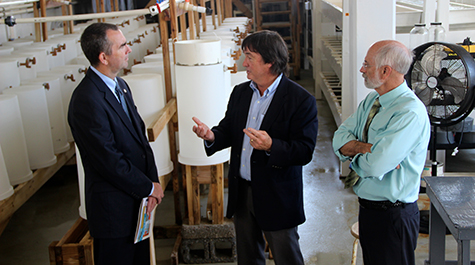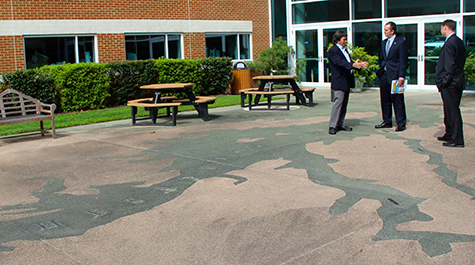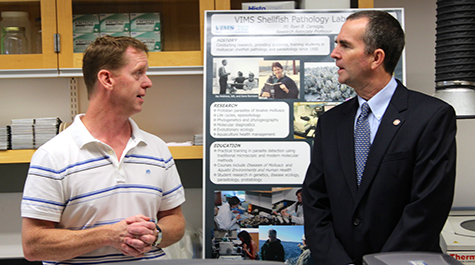Lieutenant Governor visits VIMS
Virginia’s Lieutenant Governor Ralph Northam visited the Virginia Institute of Marine Science on August 4th to learn about VIMS’ three-part mission to conduct interdisciplinary research in coastal ocean and estuarine science, educate students and citizens, and provide advisory service to policy makers, industry, and the public.
The visit began with a welcome and presentation from VIMS Dean and Director John Wells, who introduced Northam, Northam’s Chief of Staff Clark Mercer, and Policy Director Holly Coy, to some of the Institute’s most important attributes. Northam—who has a particular interest in sea level rise and oyster restoration—went on to visit researchers who represent several different units on campus that focus specifically on these issues.
“We were pleased that the Lieutenant Governor and his staff were able to take a tour of our campus and allow us to tell them more about our efforts to offer world-class research, education, and advisory service to our students and the Commonwealth,” says Wells.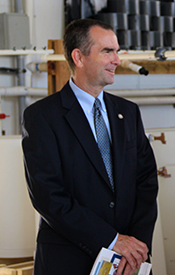

Northam’s first tour stop was at the Center for Coastal Resources Management where Marcia Berman, program manager for the Comprehensive Coastal Inventory Program, introduced him to a web portal that serves as a gateway to resources that address data gaps, best management practices for shorelines, and sea level rise issues for specific localities throughout coastal Virginia. The portal—aptly named the Comprehensive Coastal Resource Management Portal—links to guidance, data, and tools in accordance with the policy changes in tidal shoreline management adopted by the General Assembly in 2011.
Following Berman’s presentation, VIMS Marine Scientists Pamela Mason and Molly Mitchell gave a presentation explaining why living shorelines are the preferred approach to addressing tidal shoreline erosion in Virginia. The pair also discussed anticipated changes to the regulatory process as well as the social, economic, and physical vulnerabilities of Tidewater Virginia to sea level rise.
Northam’s second stop landed him right in the middle of Chesapeake Bay. Standing on a detailed map that spans the entire length of the courtyard outside of Chesapeake Bay Hall, VIMS Associate Dean of Research and Advisory Service Mark Luckenbach gave a presentation on VIMS’ efforts to restore oysters and promote aquaculture expansion in the Bay region. The map served as the perfect guide for Luckenbach to point out the areas throughout the watershed where VIMS is conducting oyster restoration research, including the VIMS Eastern Shore Lab in Wachapreague, the Kauffman Aquaculture Center in Topping, and VIMS’ main campus in Gloucester Point.
Following Luckenbach’s presentation, Northam visited Research Associate Professor Ryan Carnegie in VIMS’ Shellfish Pathology Laboratory where he learned about the impact diseases have on commercially important oysters. “Our main goal is to manage the health of oyster and clam populations and keep the industry safe from shellfish diseases,” Carnegie explained.
The last stop of the tour was in the VIMS oyster hatchery where Luckenbach discussed the history of oyster research at VIMS. Luckenbach explained how oysters—a historically keystone species in Chesapeake Bay—filter water and provide habitat for numerous Bay organisms through their reefs, but unfortunately stand at about 1% of their original population.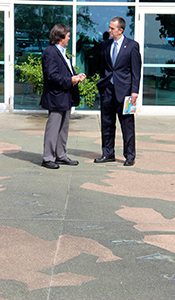

“I'm excited about all the great work we’re doing in Virginia to restore our oyster population, and had a wonderful visit with the scientists and staff at VIMS,” said Northam. “Thank you to VIMS Dean and Director John Wells and the rest of the VIMS team for an excellent and informative visit!”
The Lieutenant Governor showed his appreciation for the tour the following day, which happened to be National Oyster Day. “Shucks, today is National Oyster Day,” wrote Northam on his Twitter feed. “Thanks VIMS and @williamandmary for all you do for our oyster population!”
Lieutenant Governor Ralph Northam grew up working on Chesapeake Bay. He attended Virginia Military Institute, Eastern Virginia Medical School, and spent eight years active duty in the United States Army. A practicing pediatric neurologist at the Children’s Hospital of the King’s Daughters in Norfolk, Northam also serves as Assistant Professor of Neurology at Eastern Virginia Medical School.
Prior to being elected Lieutenant Governor in November 2013, Northam scored numerous major legislative accomplishments during his time in the State Senate from 2008-2013, including improving the health of Chesapeake Bay. Northam resides in Norfolk with his wife, Pam, who currently works for the conservation organization Lynnhaven River NOW.


